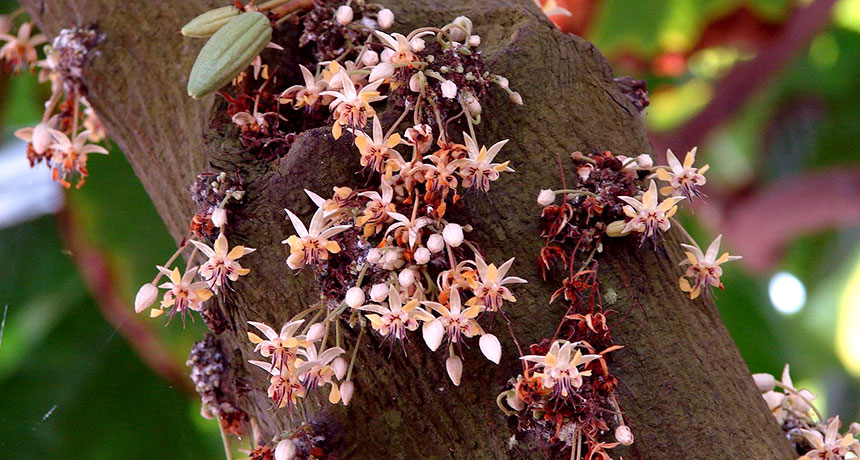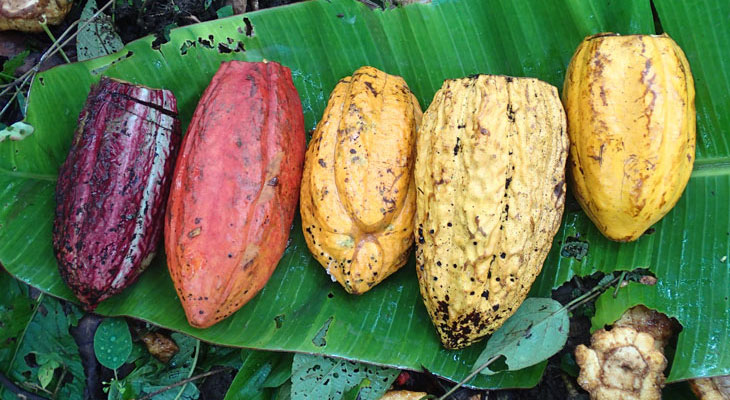Blooms on ‘chocolate’ tree are crazy-hard to pollinate
The plant’s reproductive system challenges Mother Nature’s pollen-movers

The seeds that give the world chocolate come from coy, fussy flowers that make pollination very difficult.
Tatters/Flickr (CC BY 2.0)
By Susan Milius
It’s a wonder chocolate exists. Talk about plants that resist help. Cacao trees provide the seeds from which chocolate is made. But those seeds develop only once the trees’ blooms have been pollinated. The trees’ fruit — known as pods — are created by dime-sized flowers. And those blooms are difficult. They make pollination barely possible.
Growers of other commercial fruits expect 50 to 60 percent of the flowers on their crop plant to make seeds, notes Emily Kearney. And some cacao trees manage those rates. Kearney knows. She works at the University of California, Berkeley. A biologist there, she focuses on the pollination of cacao. The problem: Pollination rates in these plants tends to be much lower — as in closer to 15 to 30 percent. But in the South American country of Ecuador, traditional plantings may contain a mix of species. There, Kearney has seen cacao pollination rates of just 3 to 5 percent.
The first sight of a blooming cacao tree (Theobroma cacao) can be “disconcerting,” she says. That’s because flowers don’t sprout from branches as in many other trees. Instead, they emerge directly from the trunk. They burst into little pink-and-white constellations of five-pointed starry blooms. Some trunks, Kearney says, “are completely covered with flowers.”
Pretty as they are, these flowers make nothing easy. Each petal curves into a tiny hood. This hood fits down around the plant’s male, pollen-making structure. To reach that pollen, a honeybee would be a useless giant blimp. So tiny flies step up to the task. Each of them is little bigger than a poppy seed. Known as chocolate midges, they are part of a family called biting midges.
After crawling up into the flowers’ hoods, they do — something.
But what? The flower offers those midges no nectar to drink. So far, researchers haven’t even shown that some scent lures in the midges. Some biologists have mused that reddish parts of the flower offer nutritious nibbling for the bugs. But Kearney knows of no tests that have confirmed this.
Another hitch to pollination: One cacao pod (resembling a wrinkled, swollen cucumber in shades of brown, purple or orange) requires from 100 to 250 grains of pollen to fertilize its 40 to 60 seeds. Yet midges typically emerge from a flower hood speckled with just a few to maybe 30 grains of the sticky white pollen. (Kearney says those pollen grains look like “clumpy sugar.”)
Story continues below image.

What’s more, the midge can’t just hike over to the female part of the same bloom. The female part sticks up in the very center of the flower, like some white-bristled paintbrush. Yet pollen is useless for any blooms on the tree it came from. That pollen won’t even work for close relatives.
To better understand cacao pollination, Kearney doesn’t suggest looking for answers at cacao farms. She says, “I think it’s the wild individuals that are going to open up the field.”
These trees evolved mostly in the Amazon Basin. There, cacao trees often grow in clusters of siblings that a monkey might have accidentally planted (while sucking pulp from a pod, dropping seeds as it fed).
To Kearney, dot-sized midges seem unlikely to fly the distance from clusters of cacao siblings to unrelated trees where cross-pollination chances would be better. So she wonders: Could the cacao with its elaborate reproductive system have a stealth, strong-flying native pollinator species that has to date escaped scientists’ notice?







